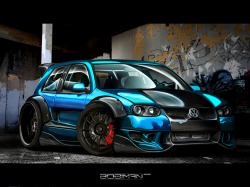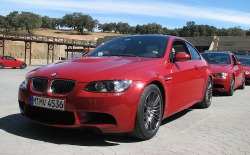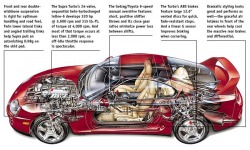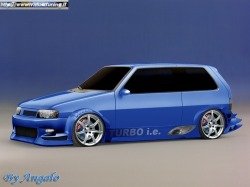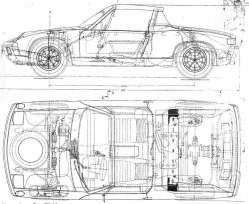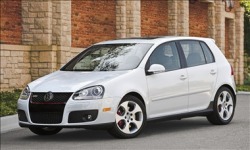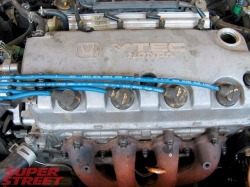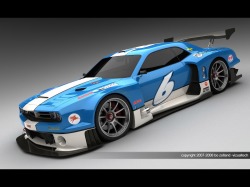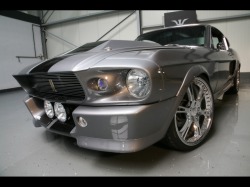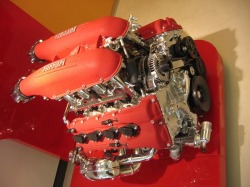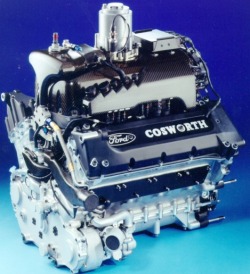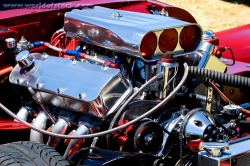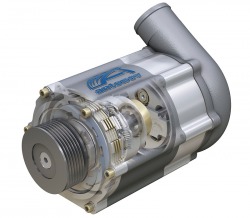BOYS AND THEIR TOYS!!!
BMW M3
The BMW M3 is a high-performance version of the BMW 3 Series compact car, developed by BMW's branch BMW M. M3 models have been derived from the E30, E36, E46 and E90/E92/E93 3-series, and sold with coupé, sedan and convertible body styles. Common upgrades over the "standard" 3-Series automobiles include more powerful and responsive (yet at times smaller) engines, improved handling/suspension, more aggressive aerodynamics/body, and multiple interior/exterior accents with the "M"/Motorsport nomenclature.
Toyota Supra
DetailsJapanese MKIVExport MKIVHorsepower
Torque
Injectors
Injector Impedance
Inlet Cam Duration
Inlet Cam Lift
Airflow Measurement
280 hp
323 ft/lb (1997 VVTi 338 ft/lb)
430 cc
High Impedance
224 deg
7.8mm
MAP sensor
320 hp
315 ft/lb
540 cc
Low Impedance
233 deg
8.25mm
Airflow sensor
Sequential Turbo's
Turbine Size
Compressor Size
Turbine material
Scroll area (mm^2)
A/R ratio
CT20A (Ceramic) see Note 1 below
60mm/48mm (inducer/exducer)
62mm/39mm (inducer/exducer)
Ceramic
600
0.42
CT12B (Steel)
52mm/44mm (inducer/exducer)
58mm/39mm (inducer/exducer)
Steel
740
0.53
Drivers Side
Bonnet scoop
Side Indicators
Headlight Covers
Front Spoiler
Brakes - Front
Brakes - Rear
Traction Control
Torsen LSD
Diff Ratio (TT)
Right
None
One behind Front Wheel
Plastic
Fixed and Retactable
pre 95 - 296mm post 95 - 323mm
pre 95 - 307mm post 95 - 324mm
ETCS
All 6 speeds, otherwise optional equipment
3.266
Left(USA/Europe) else Right
(Only Non USA export model)
Two, behind both Front/Rear Wheel
Glass
Fixed Only
323mm
324mm
TCS
Standard equipment
3.133
Wheels - Front
(50mm offset)pre 95 - 16"x8 post 95 - 17"x8"17"x8"
Wheels - Rear
(50mm offset)pre 95 - 16"x9" post 95 - 17"x9.5"17"x9.5"
0 - 100 kph
400m
5.7
13.80 @ 162 kph
5.3
13.3 @ 173 kph
Torque
Injectors
Injector Impedance
Inlet Cam Duration
Inlet Cam Lift
Airflow Measurement
280 hp
323 ft/lb (1997 VVTi 338 ft/lb)
430 cc
High Impedance
224 deg
7.8mm
MAP sensor
320 hp
315 ft/lb
540 cc
Low Impedance
233 deg
8.25mm
Airflow sensor
Sequential Turbo's
Turbine Size
Compressor Size
Turbine material
Scroll area (mm^2)
A/R ratio
CT20A (Ceramic) see Note 1 below
60mm/48mm (inducer/exducer)
62mm/39mm (inducer/exducer)
Ceramic
600
0.42
CT12B (Steel)
52mm/44mm (inducer/exducer)
58mm/39mm (inducer/exducer)
Steel
740
0.53
Drivers Side
Bonnet scoop
Side Indicators
Headlight Covers
Front Spoiler
Brakes - Front
Brakes - Rear
Traction Control
Torsen LSD
Diff Ratio (TT)
Right
None
One behind Front Wheel
Plastic
Fixed and Retactable
pre 95 - 296mm post 95 - 323mm
pre 95 - 307mm post 95 - 324mm
ETCS
All 6 speeds, otherwise optional equipment
3.266
Left(USA/Europe) else Right
(Only Non USA export model)
Two, behind both Front/Rear Wheel
Glass
Fixed Only
323mm
324mm
TCS
Standard equipment
3.133
Wheels - Front
(50mm offset)pre 95 - 16"x8 post 95 - 17"x8"17"x8"
Wheels - Rear
(50mm offset)pre 95 - 16"x9" post 95 - 17"x9.5"17"x9.5"
0 - 100 kph
400m
5.7
13.80 @ 162 kph
5.3
13.3 @ 173 kph
Fiat Uno Turbo
ENGINEType146.A8.000Number of Cylinders4 In LineFiring Order1-2-4-3Bore and Strokemm80,5 x 67,4Piston Displacementcm 31 372Compression Ratio 7,8Valve ArrangementSOHCMaximum PowerkW @ r/min85 @ 6 000Maximum TorqueN.m @ r/min161 @ 3 500Valve Clearance (Hot)Intake - mm0,35 - 0,45Exhaust - mm0,45 - 0,55ELECTRICAL SYSTEMBatteryRating - Ah35EarthNegativeAlternatorMakeBoschModelK1-14V23/65Rating - A65Starter MotorMakeBosch or M MarelliModelE80-12V-1kW or EF-12V-0,8kWOutput - kW1,0 or 0,85IGNITION SYSTEMCoilMakeMarelliModelAEI 600CDistributorMakeMarelliTypeDT 404 BXTiming - Idling Speed0 /r/min10 ± 2/900 ± 50Spark Plugs (Make / Type)NGKBCPR6ETBoschFR6DTCChampionCC7YCGap - mm0,7 - 0,8LUBRICATION SYSTEMOil Pump TypeGear PumpOil Filter TypeDisposable CartridgeFilter SystemFull FlowCOOLING SYSTEMTypeWater CooledRadiatorPressurised, pump assisted, thermostatically controlledWater Pump TypeCentrifugalThermostat TypeWax PelletFUEL SYSTEMFuel TypePetrol, leadedOctane RatingCoastal97Inland93Fuel Injection TypeBosch JetronicFuel Pump DriveElectricalFuel Filter TypeDisposable CartridgeAir Filter TypeDry Paper ElementCLUTCHSystem TypeHydraulicDiscOuter Diameter - mm200Inner Diameter - mm137TRANSMISSIONMakeFiatGear Ratios1st : 13,9092nd : 12,2673rd : 11,4694th : 11,0435th : 10,875Reverse : 13,909DIFFERENTIALMakeFiatModelIntegral Part of TransmissionRatio3,353SUSPENSIONFrontIndependent, MacPherson-type suspension with lower track control arms fastened to a cross member with two bushings and coil springs with twintube dampersRearTorsion-bar, longitudinal strut suspension with transverse link, Coil springs and twin-tube dampersBRAKESSystemHydraulicFront TypeVentilated DiscsDisc Diameter - mm240Rear TypeDiscsDisc Diameter - mm227Parking Brake TypeMechanical on rear wheelsBrake AdjustmentAutomaticSTEERING GEARTypeRack and pinionTurns - Lock to Lock4,0Turn Radius - Wall to wallm4,7WHEELS AND TIRESWheels TypeAlloy5,5Jx13Tyres - Sizes (Standard)Front175/60HR13Rear175/60HR13Tyre PressuresNormal Load Front - kPa220Maximum Load Front - kPa230Normal Load Rear - kPa220Maximum Load Rear - kPa250DIMENSIONSWheel Basemm2 362Track - SizeFront - mm1 351Rear - mm1 306Minimum Ground Clearance133LIGHTS (BULBS) 12VLoad Area Capacitycm 3248 to 968HeadlightsW60/55Front Parking LightsW3Rear LightsTail/Stop - W5/21Reverse - W21Indicator LightsFront - W21Front (Side) - W5Rear - W21License Plate LightW5Interior LightW10CAPACITIESFuel Tankl50Engine Oil - Including Oil Filterl4,05Cooling Systeml7,7Transaxlel2,0Windscreen Washerl4,75Steering Box (Grease)l0,14
NISSAN SR20 16valve TURBO
The below video is my Father in law in his Box Nissan Sentra. Fitted with a 2.0 litre Nissan Sentra STI motor, with a T2/3 turbo,and adding to that it was fitted with a DICKTATOR Fuel management System. The whole car has been resprayed and redone, from the interior to the engine mountings, 17inch wheels and one hell of a freeflow exhaust system. All done by the old man himself!
VW GOLF GTI
A sprint down the sinewy side roads of coastal Provence illustrates why Volkswagen has sold 1.7 million GTIs. Wonderfully balanced, this car loves to be driven with verve. Although purists still enjoy a brisk workout with the manual 6-speed, the DSG really makes this hatch haul.
Its 6.3-second 0-60 time and its electronically limited 129-mph top speed are about the same as last year's, but compared with the previous model, the latest GTI just looks right. And it sounds great too, thanks to a so-called "sound pipe" that channels engine sound into the passenger compartment.
Its 6.3-second 0-60 time and its electronically limited 129-mph top speed are about the same as last year's, but compared with the previous model, the latest GTI just looks right. And it sounds great too, thanks to a so-called "sound pipe" that channels engine sound into the passenger compartment.
DOHC VTEC
Honda's system is a simple method of endowing the engine with multiple camshaft profiles optimized for low and high RPM operations. Instead of one cam lobe actuating each valve, there are two: one optimized for low-RPM stability & fuel efficiency; the other designed to maximize high-RPM power output. Switching between the two cam lobes is controlled by the ECU which takes account of engine oil pressure, engine temperature, vehicle speed, engine speed and throttle position. Using these inputs, the ECU is programmed to switch from the low lift to the high lift cam lobes when the conditions mean that engine output will be improved. At the switch point a solenoid is actuated which allows oil pressure from a spool valve to operate a locking pin which binds the high RPM cam follower to the low rpm ones. From this point on, the poppet valve opens and closes according to the high-lift profile, which opens the valve further and for a longer time. The switch-over point is variable, between a minimum and maximum point, and is determined by engine load. The switch back from high to low rpm cams is set to occur at a lower engine speed than the up-switch to avoid a situation in which the engine is asked to operate continuously at or around the switch-over point.
Introduced as a DOHC system in the 1989 Honda Integra and Civic CRX SiR models sold in Japan and Europe, which used a 160 bhp (119.3 kW) variant of the B16A engine. The US market saw the first VTEC system with the introduction of the 1991 Acura NSX, which used a DOHC VTEC V6 with 290 bhp (216.3 kW). DOHC VTEC engines soon appeared in other vehicles, such as the 1992 Acura Integra GS-R (B17A 1.7 liter engine). And later in the 1993 Honda Prelude VTEC (H22 2.2 liter engine with 195hp) and Honda Del Sol VTEC (B16 1.6 liter engine). Honda has also continued to develop other varieties and today offers several varieties of VTEC, such as i-VTEC and i-VTEC Hybrid.
Introduced as a DOHC system in the 1989 Honda Integra and Civic CRX SiR models sold in Japan and Europe, which used a 160 bhp (119.3 kW) variant of the B16A engine. The US market saw the first VTEC system with the introduction of the 1991 Acura NSX, which used a DOHC VTEC V6 with 290 bhp (216.3 kW). DOHC VTEC engines soon appeared in other vehicles, such as the 1992 Acura Integra GS-R (B17A 1.7 liter engine). And later in the 1993 Honda Prelude VTEC (H22 2.2 liter engine with 195hp) and Honda Del Sol VTEC (B16 1.6 liter engine). Honda has also continued to develop other varieties and today offers several varieties of VTEC, such as i-VTEC and i-VTEC Hybrid.
ENGINES...OH SO PRETTY!
SUPERCHARGER VS TURBO
Coke vs Pepsi. Freddy vs Jason. Turbochargers vs Superchargers. The debate has raged since the dawn of time (slight exaggeration), and in the case of forced induction technology, shows no signs of stopping anytime soon. The ultimate irony is that both technologies are basically the same thing, they just derive their power in different ways. So which is better?
The Basics
Let’s start by examining the primary difference between a turbocharger and a supercharger. Cliff notes version: a turbocharger is powered by the exhaust gases of the engine whereas a supercharger is belt driven off the crank pulley. What this means is that a turbocharger uses wasted energy to make power. The drawback is that you may experience turbo lag, but that usually only happens with larger sized turbos.
Because a supercharger is belt driven, its power is based solely on the engine’s RPM’s. So the faster the motor turns, the quicker it turns the belt, which in turn produces more power. The good thing about this is that there’s no lag whatsoever. The bad thing is that because superchargers “take power to make power” there’s a potential for it to raise your gas bill. Generally, superchargers are preferred by drag racers because there’s no turbo lag. However, turbocharger technology is improving to get off the line faster.
The Basics
Let’s start by examining the primary difference between a turbocharger and a supercharger. Cliff notes version: a turbocharger is powered by the exhaust gases of the engine whereas a supercharger is belt driven off the crank pulley. What this means is that a turbocharger uses wasted energy to make power. The drawback is that you may experience turbo lag, but that usually only happens with larger sized turbos.
Because a supercharger is belt driven, its power is based solely on the engine’s RPM’s. So the faster the motor turns, the quicker it turns the belt, which in turn produces more power. The good thing about this is that there’s no lag whatsoever. The bad thing is that because superchargers “take power to make power” there’s a potential for it to raise your gas bill. Generally, superchargers are preferred by drag racers because there’s no turbo lag. However, turbocharger technology is improving to get off the line faster.
